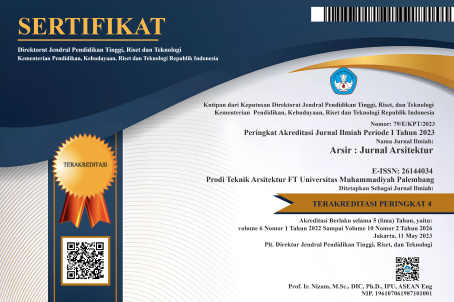Evaluation of The Use of Linear Shading and Cross-Hatching Techniques in Depicting Volume in Architectural Sketches
DOI:
https://doi.org/10.32502/arsir.v9i1.418Keywords:
architectural education, cross-hatching shading, linear shading, sketch, volumeAbstract
In architectural education, the tools or media used to convey design ideas visually are usually sketch drawings. Architectural sketches have the aim of being an architect's initial representation and exploration to explain design concepts quickly and efficiently. In the depiction, there is a technique called shading technique. Generally, the most popular shading techniques are linear shading techniques and cross-hatching shading techniques. This research was conducted to explore the effectiveness of these two shading techniques in the architectural education curriculum in Indonesia. The method used is a qualitative approach with the respondents being students of the Architecture study program at the Universitas Muhammadiyah Palembang. Data processing uses thematic analysis techniques that identify the strengths and weaknesses of each shading technique. The categorized aspects consist of volume, depth and lighting. After processing the data, it was found that the cross-hatching shading technique was more effective in producing voluminous images with depth and realistic lighting effects. Although on the other hand, students find it difficult and spend a lot of time completing the cross-hatching shading technique. Research findings show that the selection of shading techniques in architectural education still needs to be done in stages. Curriculum development needs to systematically integrate learning of all shading techniques.
Downloads
Published
How to Cite
Issue
Section
License
Copyright (c) 2025 Sisca Novia Angrini, Randy Rizal, Reny Kartika Sary

This work is licensed under a Creative Commons Attribution-ShareAlike 4.0 International License.
Arsir: Jurnal Arsitektur (AJA) have CC-BY-SA or an equivalent license as the optimal license for the publication, distribution, use, and reuse of scholarly work.
Authors who publish Arsir: Jurnal Arsitektur (AJA) agree to the following terms: Authors retain copyright and grant the Arsir: Jurnal Arsitektur (AJA) right of first publication with the work simultaneously licensed under a Creative Commons Attribution License (CC BY-SA 4.0) that allows others to share (copy and redistribute the material in any medium or format) and adapt (remix, transform, and build upon the material) the work for any purpose, even commercially, with an acknowledgement of the work's authorship and initial publication in Arsir: Jurnal Arsitektur (AJA). Authors are able to enter into separate, additional contractual arrangements for the non-exclusive distribution of the journal's published version of the work (e.g., post it to an institutional repository or publish it in a book), with an acknowledgement of its initial publication in Arsir: Jurnal Arsitektur (AJA). Authors are permitted and encouraged to post their work online (e.g., in institutional repositories or on their website) prior to and during the submission process, as it can lead to productive exchanges as well as earlier and greater citation of published work (see The Effect of Open Access).
![]()
Work is distributed below This work is licensed under a Creative Commons Attribution-ShareAlike 4.0 International License.










